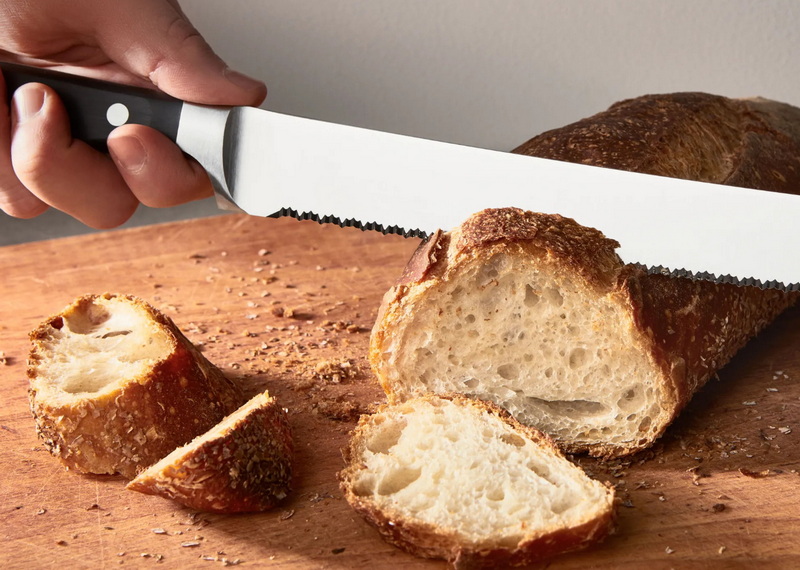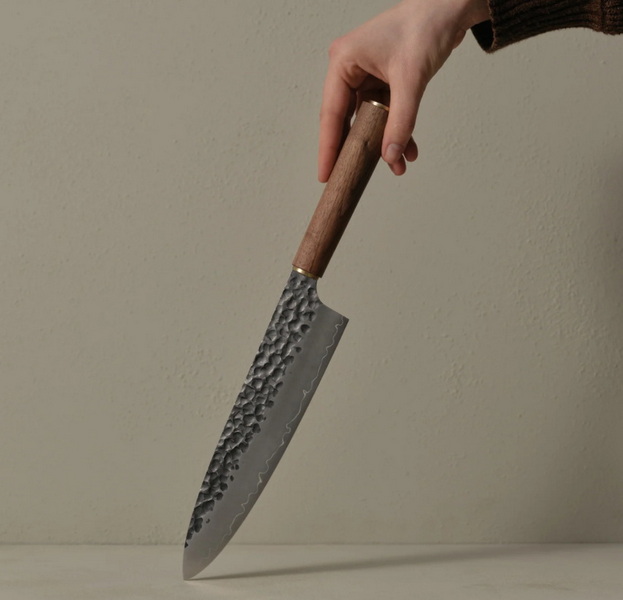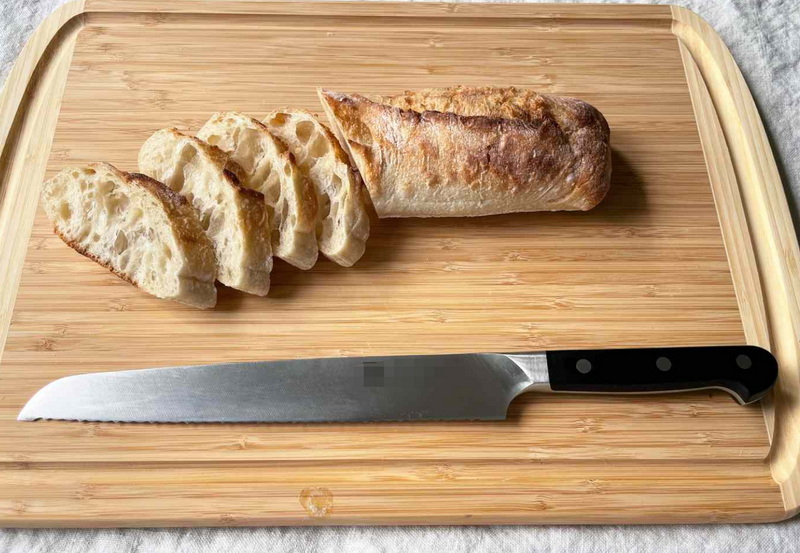- All
- Product Name
- Product Keyword
- Product Model
- Product Summary
- Product Description
- Multi Field Search
Views: 222 Author: Ann Publish Time: 2025-11-05 Origin: Site











Content Menu
● What makes a Bread Knife special
● Bread Knife in professional settings
● Choosing the right Bread Knife for OEM partners
● Market trends and positioning
● Conclusion and call to action
● FQA
>> How is bread knife length chosen for different food service needs?
>> Do serrations affect edge retention and ease of sharpening?
>> Can a bread knife handle non-bread tasks like tomatoes or pastries?
>> What maintenance is recommended for commercial bread knives?
>> What customization options are available for OEM branding and packaging?
Bread knife is more than a single-purpose tool; it is a versatile workhorse in professional kitchens, bakeries, and homes alike. A quality Bread Knife combines a thoughtfully engineered blade, durable materials, and an ergonomic handle to deliver clean, precise slices without crushing the crumb or tearing the crust. For OEM programs serving foreign brands, distributors, and manufacturers in oil and gas-adjacent markets, choosing the right Bread Knife design translates into longer product life, easier branding, and higher customer satisfaction across regions with diverse baking traditions. In this article, the Bread Knife baseline is explored from blade geometry and materials to maintenance, customization options, market positioning, and practical usage cases that demonstrate why every kitchen benefits from having a top-tier Bread Knife in their cutlery lineup.

A Bread Knife is defined by its serrated blade, which combines mechanical action with tooth geometry to shear through crusts and glide through soft interiors. The key attributes include blade length, tooth size and spacing, edge geometry, and overall balance.
- Blade length and geometry
Most professional Bread Knives fall in the 8 to 10 inch (20 to 25 cm) range. This length provides leverage for long loaves while remaining maneuverable for smaller breads and delicate pastries. A longer blade reduces tearing on large baguettes, while a shorter blade offers greater control for artisan rolls. For OEM solutions, offering a modular length option can cater to bakery chains and hotel kitchens with standardized portioning requirements. The blade's profile—straight, slightly curved, or micro-drop—affects how it tracks through the bread without snagging on crusts.
- Serration patterns and cutting action
Serrations are the defining feature of any Bread Knife. The timing and geometry of each tooth determine how effectively crusts are penetrated and how crumb integrity is preserved. Wide-set teeth with pronounced peaks penetrate tough crusts efficiently, while finer teeth can deliver a smoother pass on softer interiors. In professional contexts, a combination of push and pull action often yields the best results: the knife bites into crust with a beginning serration bite and continues through the crumb with controlled motion. Some modern designs incorporate a slightly angled serration on both faces to optimize cutting on both push and pull motions.
- Blade materials and coatings
For commercial reliability, blade material choices matter as much as geometry. Stainless steels with high corrosion resistance (such as 18/10-type equivalents) offer durability in humid environments, while high-carbon stainless steels provide edge retention under heavy usage. Some OEM programs explore advanced coatings (e.g., DLC or ceramic-infused coatings) to reduce sticking, improve corrosion resistance in salt-heavy kitchens, and extend service life. The balance between hardness, toughness, and ease of sharpening guides material selection for each market segment.
- Handle ergonomics and balance
A comfortable handle reduces fatigue during long service periods and promotes precise control. Materials range from durable polymers (polypropylene, ABS blends) to wooden or composite scales, with attention to grip texture, finger grooves, and bolster design that supports balance. For OEM collaborations, customizable handle colors, branding, and logos help integrate the Bread Knife into branded cutlery sets. A well-balanced knife minimizes wrist strain when performing repetitive slicing tasks.
The practical impact of a high-quality Bread Knife extends beyond individual slices to kitchen throughput, waste management, and brand perception.
- Bakery and restaurant workflows
In busy bakeries, bakery chains, and hotel kitchens, speed and consistency matter. A dependable Bread Knife enables staff to portion loaves rapidly, portion cakes and pastries cleanly, and portion seafood-based breaded items with uniform thickness when required. A durable blade reduces downtime for resharpening and blade replacement, contributing to smoother shift transitions and consistent menu presentation. Visuals can show line cooks using a Bread Knife to portion baguettes, demonstrate crust vs crumb integrity, and highlight reduced crumb loss compared to lower-grade tools.
- Safety and maintenance routines
Regular maintenance—including hand washing, thorough drying, and periodic honing—extends blade life and maintains cutting performance. Training staff on safe handling minimizes accidents in fast-paced environments. For OEM partners, providing a maintenance guide tailored to the buyer's region (humid coastal climates, salt exposure from seafood venues, or high-temperature kitchens) supports long-term customer satisfaction and fewer warranty claims.
- Branding and packaging considerations
OEM programs benefit from branding-ready Knives: laser-engraved logos, branded packaging, and consistent colorways that align with the buyer's portfolio. For markets with safety certifications and regulatory preferences (e.g., NSF certification in commercial kitchens), showcasing compliance can be a differentiator. Packaging can include usage tips, care instructions, and quick-start guides that reinforce brand value.
This section outlines how to configure Bread Knife offerings to meet diverse regional preferences and client requirements.
- Customization levers
- Blade length options (8–10 inches, with possible extensions for larger commercial loaves)
- Serration style and edge finish (standard serrations, micro-serration, or hybrid patterns; satin, mirror, or DLC coatings)
- Handle materials and colors (PP, PA, wood veneers, engineered composites; branding opportunities)
- Logo engraving and packaging (laser engraving on blade or handle; branded box inserts)
- Packaging formats (razor-cut plastic blade guards, magnetic slotted cases, or closed-box presentation sets)
These levers enable rapid time-to-market for distributors who require brand coherence across product families.
- Materials and coatings
Depending on the target market, select steel grades and coatings that balance hardness, toughness, and corrosion resistance. For offshore or coastal installations, coatings that minimize salt-induced corrosion and facilitate easy cleaning are advantageous. For premium restaurants, a higher hardness with easy re-sharpening cycles can justify a premium price point.

Long-term performance depends on proper care tailored to the blade material and usage environment.
- Cleaning and storage
Hand washing with mild detergent and thorough drying is generally recommended for serrated blades to prevent microscopic corrosion and staining. Storing Bread Knives in designated racks or magnetic bars helps prevent nicks and edge damage. Avoid dishwashers for most high-end serrated blades, as heat and detergents can degrade edge material and coatings over time.
- Sharpening and edge refresh
Maintaining edge geometry for Bread Knives involves periodic honing and occasional re-sharpening with appropriate tools that respect serration geometry. For OEM buyers, including a recommended sharpening schedule based on usage provides added value and reduces lifetime maintenance concerns.
Understanding current consumer preferences and culinary trends helps frame Bread Knife offerings for international markets.
- Demand drivers
Home cooks seeking durable, long-lasting tools, hotel and restaurant buyers prioritizing reliability, and bakeries requiring consistent slice quality all drive Bread Knife demand. As bread varieties evolve—artisan loaves, gluten-free options, and delicate pastries—knife design can adapt to slice through crusts while preserving crumb.
- Price positioning
A tiered approach—entry, mid, and premium—allows distributors to match customer budgets and brand promises. Warranty length, material quality, and customization options influence perceived value and lifetime cost of ownership.
- Regional considerations
Different regions favor particular materials, finishes, and aesthetics. Coastal markets may value corrosion resistance and easy cleaning, while urban hotel districts may prioritize branding and presentation. Providing region-specific product pages and localized marketing collateral can boost adoption.
A high-quality Bread Knife is not merely a cutting tool; it is a reliability anchor in professional kitchens and home settings alike. By aligning blade geometry, materials, ergonomics, and branding with target markets, OEM partners can deliver durable, restaurant-grade performance that enhances throughput, reduces waste, and elevates brand equity. For brands seeking bespoke Bread Knife solutions, samples, lead times, and a tailored catalog can accelerate time-to-market. Reach out to the OEM team to discuss design consultation, tooling feasibility, and a quotation tailored to specific regional requirements. This partnership approach ensures a Bread Knife offering that resonates with end-users and supports sustainable growth for both manufacturer and brand client.

Answer: For typical loaves, 8–10 inches strike a balance between reach and control; bakeries handling larger volumes may prefer longer blades, while small kitchens benefit from compact lengths for maneuverability.
Answer: Yes. Serrated edges are designed to maintain a saw-tooth cutting action; however, the edge life depends on steel, coating, and sharpening technique. Regular honing helps preserve performance between professional sharpenings.
Answer: It can, especially for crusted vegetables or delicate pastries, but some tasks may benefit from a blade with finer serrations or a straight edge for clean, non-scratching cuts.
Answer: Hand wash and dry promptly, avoid dishwasher exposure for coatings and serrations, and perform periodic honing with an appropriate tool to refresh the teeth without harming geometry.
Answer: Blade length, serration style, edge finish, handle material and color, logo engraving, and branded packaging inserts can be tailored to regional branding needs and regulatory requirements.
The Ultimate Professional Knives for Halal Butchery in Middle Eastern Kitchens
Chef Knife Size Guide: Choosing Between 6″, 8″, 10″, And 12″
Custom Knife Handles: How To Design A Chef Knife That Fits Your Hand Perfectly
Chef Knife Surface Treatments Guide: From Polished Migaki To Damascus Patterns
Inside Our Professional Knife Sample Room: Quality You Can See
Universal Knife Block Buying Guide: Modern Acrylic & ABS Knife Holders for Professional Kitchens
Universal Knife Block: The Complete Guide To Modern, Hygienic Knife Storage
The Complete Guide To Red Handle Knife Sets: Style Meets Functionality in The Kitchen
Professional Knives for Halal Butchery And Middle Eastern Cuisine